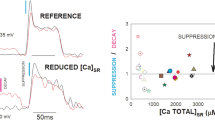Abstract
THE ryanodine receptor protein of skeletal muscle sarcoplasmic reticulum (SR) membranes is a calcium ion channel which allows movement of calcium from the SR lumen into the cytoplasm during muscle activation1–5. Gating of this channel is modulated by a number of physiologically important substances including calcium. Interestingly, calcium has both activating and inactivating effects which are concentration- and tissue-specific. In skeletal muscle, calcium-dependent inactivation of calcium release occurs at concentrations reached physiologically, suggesting that calcium may modulate the release process by a negative feedback mechanism6–9. To determine the cellular mechanism responsible for calcium-dependent inactivation, we have investigated the ability of protein phosphorylation to affect single channel gating behaviour using the patch clamp technique. Here we demonstrate that the ryanodine receptor protein/calcium release channel of skeletal muscle SR is inactivated under conditions permissive for protein phosphorylation. This inactivation is reversed by the application of phosphatase and prevented by a peptide inhibitor specific for calcium/cal-modulin-dependent protein kinase II. The results provide evidence for an endogenous protein kinase which is closely associated with the ryanodine receptor protein and regulates channel gating.
Similar content being viewed by others
References
Imagawa, T., Smith, J. S., Coronado, R. & Campbell, K. P. J. biol. Chem. 262, 16636–16643 (1987).
Hymel, L., Inui, M., Fleischer, S. & Schindler, H. Proc. natn. Acad. Sci. U.S.A. 85, 441–445 (1988).
Lai, F. A., Erickson, H. P., Rousseau, E., Liu, Q.-Y. & Meissner, G. Nature 331, 315–319 (1988).
Catterall, W. A. Cell 64, 871–874 (1991).
Smith, J. S. et al. J. gen. Physiol. 92, 1–26 (1988).
Baylor, S. M., Chandler, W. K. & Marshall, M. W. J. Physiol. 344, 625–666 (1983).
Schneider, M. F. & Simon, B. J. Physiol. 405, 727–745 (1988).
Simon, B. J., Klein, M. G. & Schneider, M. F. J. gen. Physiol. 97, 437–471 (1991).
Kwok, W.-M. & Best, P. M. Pflügers Arch. 419, 166–176 (1991).
Stein, P. & Palade, P. Biophys. J. 54, 357–363 (1988).
Hals, G. D., Stein, P. G. & Palade, P. J. gen. Physiol. 93, 385–410 (1989).
Morii, H., Takisawa, H. & Yamamoto, T. J. Biochem. 102, 263–271 (1987).
Lüttgau, H. C. & Oetliker, H. J. Physiol., Lond. 194, 51–74 (1968).
Campbell, K. P. & MacLennan, D. H. J. biol. Chem. 257, 1238–1246 (1982).
Tuana, S. T. & MacLennan, D. H. FEBS Lett. 235, 219–223 (1988).
Chu, A., Sumbilla, C., Inesi, G., Jay, S. D. & Campbell, K. P. Biochemistry 29, 5899–5905 (1990).
Malinow, R., Schulman, H. & Tsien, R. W. Science 245, 862–865 (1989).
Wagner, J. A. et al. Nature 349, 793–796 (1991).
Chung, S., Reinhart, P. H., Martin, B. L., Brautigan, D. & Levitan, I. B. Science 253, 560–562 (1991).
Takeshima, H. et al. Nature 339, 439–445 (1989).
Hanks, S. K., Quinn, A. M. & Hunter, T. Science 241, 42–52 (1988).
Witcher, D. R., Kovacs, R. J., Schulman, H., Cefali, D. C. & Jones, L. R. J. biol. Chem. 17, 11144–11152 (1991).
Kim, D. H. & Ikemoto, N. J. biol. Chem. 261, 11674–11679 (1986).
Author information
Authors and Affiliations
Rights and permissions
About this article
Cite this article
Wang, J., Best, P. Inactivation of the sarcoplasmic reticulum calcium channel by protein kinase. Nature 359, 739–741 (1992). https://doi.org/10.1038/359739a0
Received:
Accepted:
Issue Date:
DOI: https://doi.org/10.1038/359739a0
- Springer Nature Limited
This article is cited by
-
CaMKII content affects contractile, but not mitochondrial, characteristics in regenerating skeletal muscle
BMC Physiology (2014)
-
Inhibition of mouse neuromuscular transmission and contractile function by okadaic acid and cantharidin
British Journal of Pharmacology (2000)
-
Physiologic and emerging pathophysiologic role of cardiac calcium channels
Heart Failure Reviews (1996)
-
Potentiation of sarcoplasmic reticulum Ca2+ release by 2,3-butanedione monoxime in crustacean muscle
Pfl�gers Archiv European Journal of Physiology (1993)





